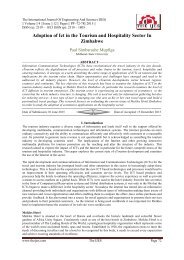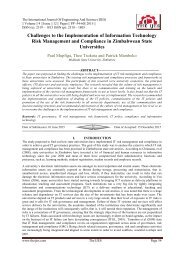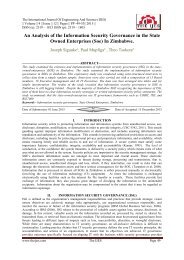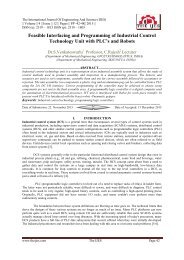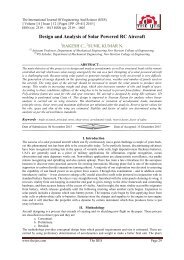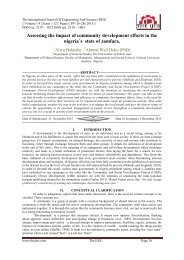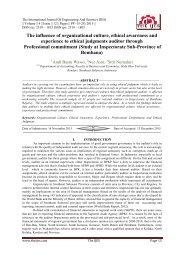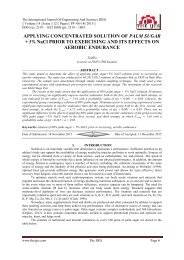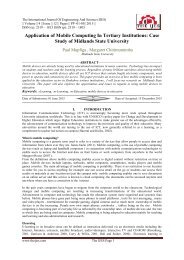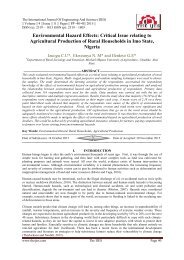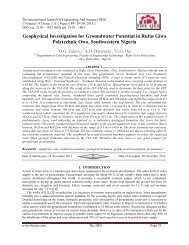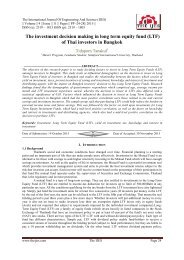M021203090093.pdf
Create successful ePaper yourself
Turn your PDF publications into a flip-book with our unique Google optimized e-Paper software.
Studies on the Repellent Activities of Four Common Asteraceae in Nigeria against Red Flour Beetle…<br />
2.1 Selection and collection of plant species<br />
The selection of plants used in the study was based on previously reported insecticidal and repellence<br />
properties of the plants against storage insect pests. The plants, with the exception of Tridax procumbens,<br />
which was collected within Ondo town, were all collected from the main campus, Adeyemi College of<br />
Education, Ondo. The leaf part of the plant was plucked by hand and put in a jute bag. The plant materials were<br />
subsequently dried under shade for 6 days and pulverized using wooden pestle and mortal. Sieving of the<br />
pulverized plant materials was done and 100g of the prepared leaf powder was kept in an air tight container for<br />
the purpose of the experiment.<br />
2.2 Repellency study<br />
The repellency test adopted the cup bioassay method described by Mohan and Fields (2002) with little<br />
modifications. The leaf powders of the four plant species of asteraceae were evaluated for their repellent effect<br />
against red flour beetle, T. casternum at the rate of 0%, 2.5% and 5.0%. The experiment was a completely<br />
randomized design with five treatments and four replicates. The twenty adult insects that were used in the<br />
experiment were sieved out and placed gently in the middle of the perforated plastic container that holds 100g of<br />
wheat grains admixed with leaf powder and chemical insecticide treatments. Repellence was determined by the<br />
number of insects leaving the treated grain compared to the untreated controls.<br />
2.3 Statistical Analysis<br />
A two-way analysis of variance (ANOVA) was performed on data after transformation using square<br />
root and arcsine to determine repellent activity of the leaf powders of the four selected asteraceae at different<br />
concentrations and duration of exposure. Differences in mean repellency of treatments were compared using<br />
Students Newman Keuls(SNK) at p < 0.05.<br />
III. RESULTS<br />
The repellence of adult red flour beetle, Tribolium casternaeum to leaf powders of Chromolaena<br />
odorata, Ageratum conyzoides, Tridax procumbens and Vernonia amygdalina at different concentrations and<br />
period of exposure are depicted in figures 1, 2, 3, 4 and 5 respectively. The results indicate variation in<br />
repellence effectiveness of the selected plants. The rate of movement of adult red flour beetle from the<br />
perforated cylindrical cup which indicates repellence increased with increase in concentrations of the leaf<br />
powders and duration of exposure. The response of adults of T. castaneum to treatments of powders of the four<br />
asteraceae plant species was fastest for T. procumbens. At the highest concentration (5%) and duration of<br />
exposure(12 hours) adult red flour beetle elicited 79% repellence. This was closely followed by V. amygdalina<br />
with 68% repellence. The order of repellency effects of four powdered asteraceae species at the highest dosages<br />
and duration of exposure was Tridax procumbens > Vernonia amygdalina > Ageratum conyzoides ><br />
Chromolaena odorata.<br />
Figure 1. Repellency of Chromolaena odorata leaf powder to adult red flour beetle, Tribolium castaneum.<br />
www.theijes.com The IJES Page 91



